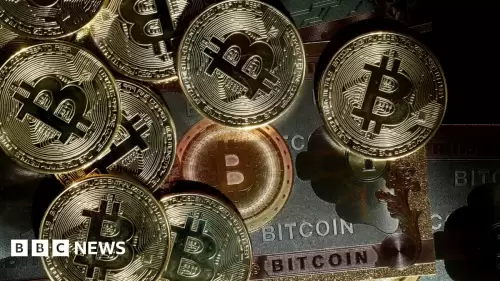 |
|
 |
|
 |
|
 |
|
 |
|
 |
|
 |
|
 |
|
 |
|
 |
|
 |
|
 |
|
 |
|
 |
|
 |
|
Articles d’actualité sur les crypto-monnaies
Trading firm QCP Capital has released a new report analyzing unexpected, tectonic shifts in currency markets and their potential impact on the cryptocurrency sector
May 06, 2025 at 08:20 pm

Taiwan's dollar soared 8 percent on Thursday, with the Korean won and other Asia-Pacific currencies with large, persistent current account surpluses also showing gains against the U.S. dollar.
The move saw the spread between the TWD spot rate and the one-year non-deliverable forward widen to 3,000 points, reaching a two-decade high, while trading volumes surged to levels last seen during the 2008 financial crisis.
What Is a Non-Deliverable Forward?
A NDF (Non-Deliverable Forward) is a special financial instrument that allows market participants to transact in currencies whose trading is restricted or hindered by national regulations. Unlike conventional forward contracts, there is no physical delivery of the underlying currency upon execution of NDFs.
The principle behind NDFs is that two parties agree to exchange currencies at a predetermined rate on a specific future date. However, on the settlement date, only the difference between the contracted forward rate and the actual spot rate is settled. Settlement is usually made in a freely convertible currency, most commonly US dollars.
In the context of Taiwan, the wide spread between the spot rate and the NDF suggests considerable uncertainty and speculative pressure on the currency. It indicates a serious discrepancy between the current market valuation of the Taiwan dollar and expectations of its future value.
Reasons for the currency rally
Taiwan is a key net exporter to the US, with its economy heavily reliant on its dominant semiconductor industry. While trade surpluses typically drive structural strengthening of the TWD, this has traditionally been offset by sustained capital outflows. Taiwanese residents hold significant unhedged US dollar assets, which help balance currency dynamics.
The sharp strengthening of the TWD appears to be driven by growing speculation surrounding a potential trade agreement between the US and Taiwan. This is coupled with increased hedging flows from local insurance companies managing dollar risk.
Parallels with the Yen
This situation is reminiscent of the sharp carry-trade reversal in the Japanese yen against the US dollar on August 4 last year. Japan's deep negative yield differential with the US became unsustainable amid macroeconomic shifts.
The negative yield differential meant that interest rates in Japan were significantly lower than in the US. This allowed investors to borrow money in Japan at low interest rates and invest in U.S. assets with higher yields, capitalizing on the difference. When the economic situation changed, this differential became unsustainable, leading to a massive unwinding of such positions and a sharp appreciation of the yen.
While the TWD does not have global reserve status like the JPY, this movement could signal early challenges to existing investment positions in the forex market and a potential reallocation of global capital flows.
Why Is This Important for Cryptocurrencies?
The situation on the cryptocurrency market is quite calm now – there are no sharp price hikes, and the value of digital assets is fluctuating within a narrow range without clear direction. Options traders do not expect significant price changes in the near future.
Meanwhile, currency turmoil coincided with gold’s nearly 3 percent rise on Thursday, as investors braced for a weaker dollar and priced in a geopolitical risk premium, including prospects for U.S. trade diplomacy.
Trading Strategies from QCP
In its report, QCP Capital highlights two possible avenues traders can consider navigating this eventuality.
The first scenario envisages a volatility shock in which Bitcoin detaches itself from gold as a safe haven and begins to play the role of a risky asset once again. This scenario suggests preparing for a potential spike in volatility in the cryptocurrency market in response to the currency crises. To implement this strategy, traders may want to buy options with high gamma exposure, which benefit from sharp price movements regardless of direction.
The second scenario could provide tailwind for trade diplomacy. A stronger Taiwan dollar would strengthen Taiwan’s negotiating position, potentially increasing the likelihood of a trade agreement with the U.S. Under this strategy, investors could consider acquiring assets that have historically benefited from improved trade relations between the U.S. and Asian economies, including certain crypto assets with strong ties to the region.
Each of these strategies requires careful consideration of market conditions and an individual trader’s risk profile. In a market environment where correlations are weakening, currency markets could once again become the canary in the coal mine for the macro economy, concludes QCP.
The Bottom Line
Financial markets stand at a bifurcation point, where currency movements could foreshadow greater structural shifts. Today’s upheavals in the foreign exchange market may shape tomorrow’s trends in digital assets. Closely tracking the interrelationships between traditional financial markets and cryptocurrencies is becoming a crucial skill for investors aiming to stay ahead of market cycles.
Clause de non-responsabilité:info@kdj.com
Les informations fournies ne constituent pas des conseils commerciaux. kdj.com n’assume aucune responsabilité pour les investissements effectués sur la base des informations fournies dans cet article. Les crypto-monnaies sont très volatiles et il est fortement recommandé d’investir avec prudence après une recherche approfondie!
Si vous pensez que le contenu utilisé sur ce site Web porte atteinte à vos droits d’auteur, veuillez nous contacter immédiatement (info@kdj.com) et nous le supprimerons dans les plus brefs délais.
-

- Bitcoin, baisse des taux de la Fed et Crypto Stocks: une prise de New Yorker
- Aug 05, 2025 at 01:23 pm
- Naviguer dans le buzz crypto: la résilience du bitcoin, les chuchotements de réduction du taux de la Fed et la montée des stocks de crypto. Obtenez le scoop intérieur sur cette frontière financière.
-

- Police, crypto-monnaie, bitcoin Windfall: gains inattendus et histoires de prudence
- Aug 05, 2025 at 01:18 pm
- Des forces de police bénéficiant de bitcoin au bitcoin aux avertissements sur les escroqueries des crypto-monnaies, nous nous plongeons dans l'intersection des forces de l'ordre et des actifs numériques.
-

- Magacoin: Le prochain shiba inu roi? Une plongée profonde de prévente de la crypto
- Aug 05, 2025 at 01:07 pm
- Magacoin est-il la prochaine crypto à exploser comme Shiba Inu? Nous analysons sa prévente, sa communauté et son retour sur investissement potentiel dans cet aperçu du marché des pièces mèmes.
-

- Bitmine's Ethereum Treasury: A New York Minute to Crypto Domination
- Aug 05, 2025 at 01:01 pm
- L'accumulation rapide par Bitmine d'Ethereum a déclenché une course parmi les bons du Trésor cryptographique, poussant ses avoirs à plus de 3 milliards de dollars et solidifiant sa position en tant qu'acteur majeur.
-

- Boom des intérêts ouverts d'Ethereum: comment le capital institutionnel change le jeu
- Aug 05, 2025 at 12:37 pm
- L'intérêt ouvert d'Ethereum atteint des sommets record alors que les investisseurs institutionnels affluent vers Eth, dessinés par Defi et Smart Contrac Innovation. Mais ce boom est-il durable?
-

- Bitcoin, Kiyosaki et la malédiction d'août: L'histoire se répétera-t-elle?
- Aug 05, 2025 at 12:07 pm
- Robert Kiyosaki met en garde contre un accident potentiel de Bitcoin en août en raison de la «malédiction d'août», mais le voit comme une opportunité d'achat. L'histoire est-elle sur le point de se répéter?
-

- L'étoile de la décoloration de XRP: Remittix (RTX) est-elle l'avenir de l'adoption de la crypto?
- Aug 05, 2025 at 12:01 pm
- XRP fait face à des défis car Remittix (RTX) gagne du terrain. Ce blog explore la transition vers la crypto axée sur les services publics et le potentiel de RTX dans l'espace PayFi.
-

-

- Ethereum Treasury Titans: l'accumulation d'entreprise de Bitmine et la révolution de l'ETH
- Aug 05, 2025 at 12:00 pm
- Plongez dans le monde des bons du Trésor Ethereum, de l'accumulation d'entreprise et des mouvements stratégiques de Bitmin. Découvrez les tendances et les idées qui façonnent l'avenir de l'ETH.




























































